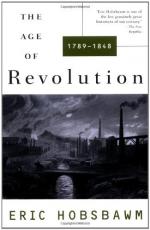
|
| Name: _________________________ | Period: ___________________ |
This test consists of 15 multiple choice questions and 5 short answer questions.
Multiple Choice Questions
1. Who dominated the Third Estate in the 1780s in France?
(a) Revolutionaries and radicals.
(b) The nobility.
(c) The working poor.
(d) The middle class.
2. What was the age of scientific and political progress in the 1700s called?
(a) The Renaissance.
(b) The Enlightenment.
(c) Modernism.
(d) The Romantic period.
3. In what did England lead Europe, in Hobsbawm's account?
(a) Raw material production.
(b) Per capita trade.
(c) Political freedoms.
(d) Moral philosophy.
4. Which nation led the others in industrialization?
(a) Russia.
(b) Britain.
(c) France.
(d) Prussia.
5. Where did Britain expand its relationships after the French Revolution?
(a) With Russia and Prussia.
(b) With China and Indonesia.
(c) With its colonies.
(d) With France and Spain.
6. What did the monarchy do in response to France's financial crisis in the 1780s?
(a) He called a States General.
(b) He borrowed from the merchants.
(c) He outsourced the business of governing.
(d) He proposed new taxes.
7. What does Hobsbawm say was the greatest influence on political thought in the 19th century?
(a) The ancient Greeks.
(b) The Renaissance.
(c) The French Revolution.
(d) The Industrial Revolution.
8. Why didn't France invade any territories after the French Revolution?
(a) The price of reintroducing Jacobinism was too high.
(b) The country was struggling with internal dissensions.
(c) The government could not raise an army large enough for any invasions.
(d) The country was burdened with too much debt.
9. Europe was ruled by Britain, France, Austria, Prussia and which nation?
(a) Russia.
(b) China.
(c) Greece.
(d) Romania.
10. What was the result of improvements in the technology of spinning and weaving?
(a) Decreased farm size.
(b) Increased output.
(c) Decreased need for labor.
(d) Increased tax revenue from the cotton trade.
11. What crucial event does Hobsbawm say took place during the period after the French Revolution?
(a) The abolition of the slave trade.
(b) The discovery of Australia.
(c) The development of paper currency.
(d) The invention of the cotton gin.
12. What was the Code of Napoleon?
(a) The bureaucratic system instituted in France.
(b) The reform that abolished feudalism.
(c) The currency policy that financed the Napoleonic wars.
(d) The criminal law instituted by Napoleon.
13. What does Hobsbawm call the Industrial Revolution?
(a) "the end of classical Europe."
(b) "the most important event in world history."
(c) "preparation for some of the greatest changes mankind would know."
(d) "the beginning of the modern age."
14. Where does Hobsbawm say the first wave of revolutions took place after the French Revolution?
(a) In the Americas.
(b) In the Mediterranean.
(c) In Asia.
(d) In Eastern Europe.
15. Where does Hobsbawm see a culture combining nationalism with the revolutionary spirit of the French Revolution?
(a) Albania.
(b) Greece.
(c) Ireland.
(d) Poland.
Short Answer Questions
1. What idea does Hobsbawm say was just being developed after the turning point of 1830?
2. What cause did Russian and Britain support together after the French Revolution?
3. Why didn't disagreements between nations reach the level of international war?
4. Who dominated the Orthodox Church in 1848?
5. What was production freed from in the 1780s?
|
This section contains 529 words (approx. 2 pages at 300 words per page) |

|




